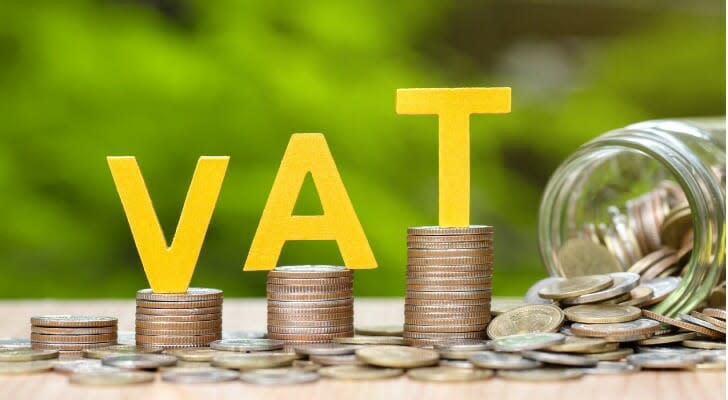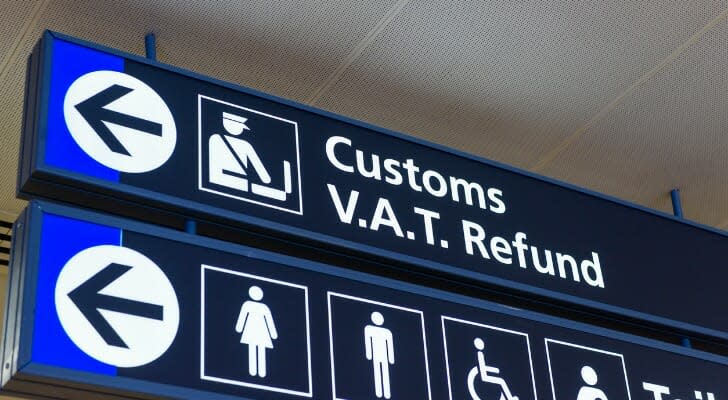Value-Added Tax (VAT): A Guide for Business Owners
Value-added taxes (VAT), which are a type of consumption tax, are major sources of revenue for countries in the Organization for Economic Co-operation and Development (OECD), among other regions. According to the Tax Foundation, VAT actually contributed to one-third of the OECD countries’ tax revenue in 2019. In contrast, the U.S. relies more heavily on property and individual income taxes, with only approximately 17.6% of revenue coming from consumption taxes. Here’s what you should know about the VAT.
A financial advisor can help with taxes and any other financial issues you may have.
How a VAT Works
The VAT is a consumption tax because it’s based on, essentially, spending money rather than earning money. It is levied on services and goods at every stage of the supply chain.
The VAT taxation system is popular in many countries, but it’s more common in certain parts of the world. For example, all European countries levy a VAT, according to the Tax Foundation. However, the U.S. does not have such a system in place. Instead, it uses local or state sales taxes.
When a company sells the raw materials for a product to a factory, the tax gets added. Similarly, a VAT gets added on each time the good or service gains value and trades hands. So from the factory to wholesaler, from wholesaler to retailer and from retailer to consumer the VAT is applied each step of the way.
VAT is usually expressed as a percentage. For example, suppose a consumer buys a good for $50 with a 10% VAT to the retailer. The consumer pays $55 total, and the retailer keeps $50 of it. The rest goes to the government.
It’s understandable for many people to think VAT and sales tax are the same thing. But the VAT system implements a tax at every level of production. So, everyone who engages in creating the product or service pays a VAT. In contrast, a sales tax only gets implemented at the last stage, when the consumer purchases the product.
Special Considerations for Business Owners
The VAT system likely leads to greater costs for business owners, and not just at the manufacturer or retailer level. It impacts every owner throughout the production chain. That’s because each level of production must calculate the required taxes at their stage in the chain. That results in more paperwork and accounting.
VAT can also be difficult for companies that work beyond a national scale. This is because global firms have to consider the tax regimes of every country that the supply chain runs through.
However, in countries that use it, businesses can generally reclaim VATs for tax-deductible business expenses where the tax.
Example of a VAT
You can calculate the VAT paid at each stage in the production of an item by subtracting the previously charged VAT from the most recent stage’s VAT. For example, Great Britain’s standard VAT rate is 20% for most goods and services. Suppose there is a manufacturer of jewelry based in Great Britain. The group needs to purchase the raw materials, like precious metals, from a dealer. As the seller in the exchange, the dealer charges the manufacturer $5, including the 20% VAT. The dealer collects the payment and sends the VAT amount to the government.
After the manufacturer creates the jewelry’s components, it sells the parts to an assembler for $10, including a $2 VAT. But the manufacturer only sends $1 to the government because it keeps the VAT amount it already paid to the raw material seller. Because the manufacture paid $1 to the raw material seller, it only pays a $1 VAT ($2 – $1) to the government, otherwise known as incremental VAT.
Ultimately, the entire VAT passes to consumers, who pay the total sum of the VAT, which the previous buyers paid throughout the production process – but without the reimbursement those previous buyers enjoyed. In the case of the jewelry, let’s say the consumer bought a ring for $40. The VAT rate is still 20%, so the consumer pays an $8 VAT and $48 total for the ring.
VAT Pros and Cons
The pros and cons depend on who you are talking to about them. For example, some advocates see a strong benefit for consumers when it comes to VAT. A VAT is generally seen as a regressive tax system because the percentage of the VAT is the same for rich or poor, big corporations or tiny startups. Unlike a progressive tax, such as the U.S. income tax, a VAT comes at a fixed rate. So, lower earners technically pay more, proportional to their income, than higher earners. In effect, that makes goods and services more expensive and thus less accessible to low-income groups. As a result, critics claim the VAT system would lead to a fall in consumer purchasing power.
However, supporters view the fixed percentage of a VAT as an incentive for consumers to work toward higher salaries. The incentive, some argue, would increase overall gross domestic product (GDP). Supporters also say that since a VAT is part of the purchase. That means the government increases revenue by minimizing tax evasion.
The Takeaway
A value-added tax is a flat tax levied on goods and services throughout the production process. Each buyer in that process pays the tax, but ultimately the consumer is responsible for the full tax amount since they don’t receive reimbursement like others in the chain of production. While the U.S. does not currently use VATs, some believe it might be beneficial, arguing that the flat rate might incentivize workers as well as increase revenue for the government. However, others say its costs would land disproportionately on low-income workers. They would pay more proportionally for it than their high-income counterparts.
Tips on Taxes
While the U.S. doesn’t have a VAT, there are plenty of others for the future retiree to worry about. A financial advisor can help you plot out a tax strategy that protects your retirement income. Help is at your fingertips with SmartAsset’s free matching tool. Within five minutes, the program matches you with qualified local advisors. If you’re ready to work with a financial advisor, get started now.
Income in America is taxed by the federal government, most state governments and many local governments. The federal income tax system is progressive, so the rate of taxation increases as income increases. Use this free calculator to get a good estimate of what your federal income taxes will be.
The amount you pay in taxes depends in part on your state’s retirement friendliness. If your state uses harsher rules, consider relocating to another with fewer taxes that could impact you as a retiree. However, if your state is retirement friendly, you may only need to move down the street. Downsizing to a smaller home can help minimize housing costs and associated property taxes.
Photo credit: ©iStock.com/pcess609, ©iStock.com/Stephen Barnes, ©iStock.com/AsiaVision
The post Value-Added Tax (VAT): A Guide for Business Owners appeared first on SmartAsset Blog.

 Yahoo Finance
Yahoo Finance 


